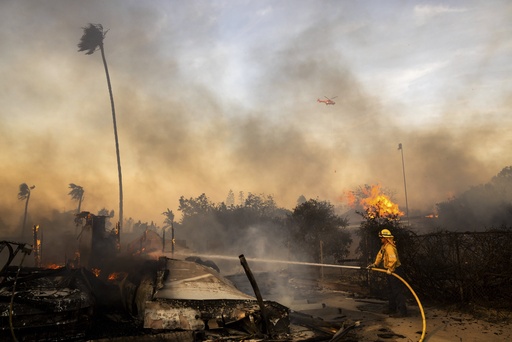
LOS ANGELES — With devastating wildfires raging on both coasts, officials managing fire response operations may use terminology that is not familiar to residents from regions where such large fires are uncommon.
Here’s a breakdown of key wildfire terminology:
**Containment vs. Extinguishment**
Fire management teams provide regular updates on the level of containment achieved. For instance, when a fire is reported as 25% contained, this indicates that crews have successfully established a fire line around a quarter of the blaze’s boundary. A fire line typically consists of a dirt path carved out by firefighters using bulldozers or hand tools, which acts as a buffer between the fire and the surrounding vegetation, including grass, brush, and trees that could fuel it. In some situations, these lines are bolstered with flame retardants released from aircraft. Fire lines may also utilize natural barriers such as roads, rocky terrains, or rivers, and are sometimes referred to as fuel breaks.
When a fire reaches 100% containment, it does not necessarily mean the fire is extinguished, but rather that it is under control. According to the U.S. Forest Service, a fire is deemed controlled once it is fully contained, and firefighters have eliminated active flames and smoldering materials while also removing unburned fuels from a distance of roughly 300 feet inside the containment line. Fire crews may take several days to ensure that any hotspots are sufficiently cooled to minimize the risk of flames escaping beyond the fire line.
A fire is considered “out” when no heat hotspots or smoke are detected within the established lines for a minimum of 48 hours. However, monitoring and patrols often continue for large wildfires until rain or snow comes to quench all signs of smoke. It is not unusual for these fires to burn for weeks or even months.
**Evacuation Warnings**
In the face of imminent danger from fire, authorities may issue evacuation orders. However, they cannot compel individuals to evacuate. Typically, law enforcement will conduct door-to-door notifications to inform residents that their safety may be at risk.
Evacuation warnings are put in place to alert residents that conditions are worsening and they should be ready to leave at short notice. As Russ Lane, the fire operations chief for the Washington State Department of Natural Resources, indicated in 2021, emergency managers weigh several factors before issuing an evacuation order, including the behavior of the fire, weather predictions, and the time required for safe egress from the area.
They also take into account the availability of shelters and the potential risks to human life. Occasionally, officials may issue a “shelter in place” command. This is typically enforced when there is insufficient time to escape the oncoming fire or if staying put is deemed safer than evacuating, as explained by Lane.
**Mopping Up**
Firefighting crews remain on-site for extended periods, sometimes days or weeks, working to clear areas that have burned. Their tasks include cutting down unstable trees, removing brush and other combustible materials that could reignite, clearing roadways, and generally ensuring that the affected area is as safe as possible for both residents and emergency responders.
